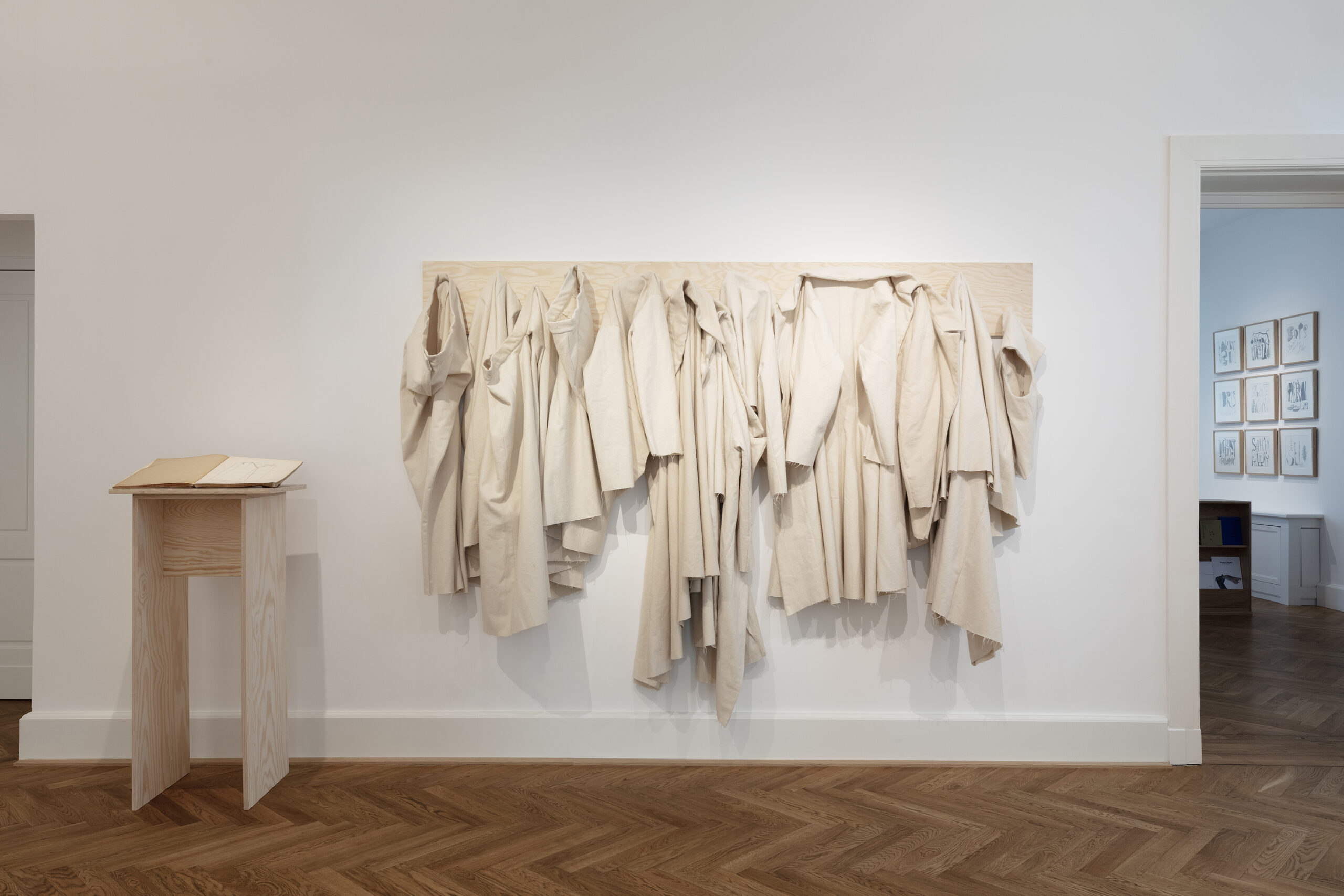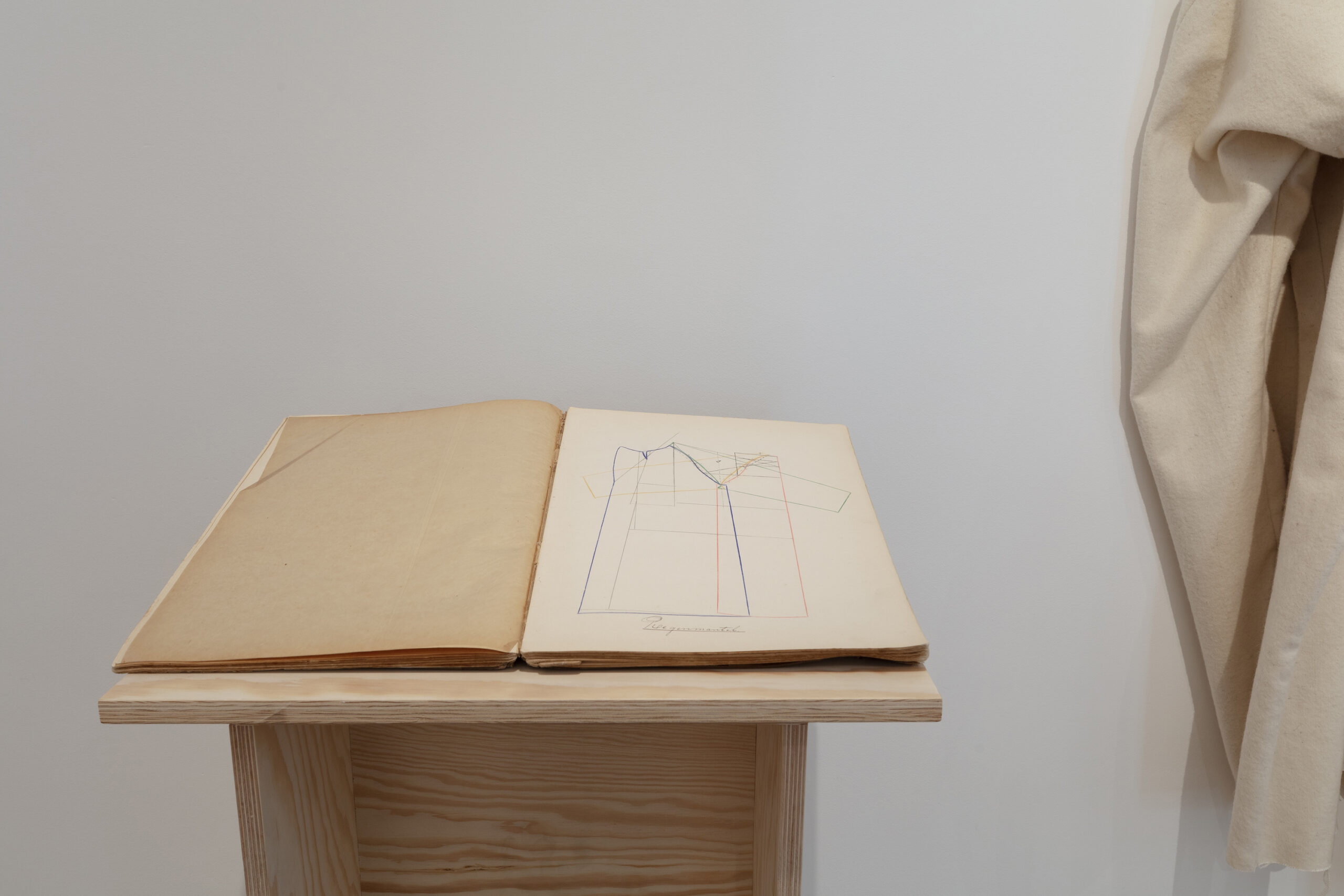Our collaborative work Wayside (Antoinette van Eyck’s Collection of Garments) was exhibited in the group exhibition TRANSIT, Zilberman Gallery, Berlin, curated by Lotte Laub and Susanne Weiß with participating artists: Yane Calovski & Hristina Ivanoska, Antje Engelmann, Memed Erdener, Hanna Frenzel, Itamar Gov, Fatoş İrwen, İz Öztat & Zişan & BAÇOY KOOP, Judith Raum, Sim Chi Yin, Annette Weisser. Photo: Chroma. (30.04.–29.07.2023)
https://www.zilbermangallery.com/transit-eng-e342.html


Wayside (Antoinette van Eyck‘s Study of Garments, 1935), 2019. Installation: series of 12 textiles, wood, metal and book. Variable dimensions.
In our collaborative practice we combine narratives with divergent context. Therefore, it was an opportunity to connect two stories by realising the garments from Antoinette van Eyck’s pattern book with fabrics from the Teteks factory in Macedonia to contextualise their connection to modernity, female labour and the production of textiles.
This work focuses on a discovered archive in the form of a workbook by a Dutch student, Antoinette van Eyck, who attended a one-year tailoring course in Utrecht in 1935. Between 2017 and 2019, we translated a selection of her impressive pencil-coloured constructions into tailored garments using fabric provided by one of the textile industry giants in Macedonia, Teteks. This predominantly woollen material, available only in its natural colour, was produced specifically for the food industry to cover rising dough. The rapidly growing and changing textile industry in pre-Second World War Europe transferred the women’s domestic production of unique fabrics and garments, mostly created in long hours of isolation and solitude, into mass production of unified and standardised products, creating an industrial context of craft and labour process control, a predominance of skilled labour, and a significant labour movement. In this changing economy, women’s struggles to substitute private for public space and to live and compete on an equal footing positions them at the critical forefront of society. Antoinette van Eyck’s investment in education and craft would allow her to enter the new world of progress and economic independence. Nevertheless, we should remember that Europe is at the door of the catastrophe of the Second World War.
On the other hand, we have the history of the factory Teteks, which began on 25 May 1951 with the commissioning of the spinning machine for woollen yarn. The factory is intrinsically linked to female labour participation in the fast post-war industrialisation of that time in rural Macedonia. The emergence of this textile giant is synonymous with the growth of the Macedonian textile sector, which has undergone diverse historical and economic phases. In 1991, the declared independence of the state and the changing of the political and economic system affected the transformation of the factory Teteks from a socialist enterprise to a private joint-stock company, and today it is 100 per cent privatised, facing challenges for its survival and development, transforming itself and adapting to new market conditions. However, as a relatively new democracy and ‘country in transition’, North Macedonia was faced with the ruthless race of capital accumulation, which included complex relations and hierarchies of power. The country is experiencing all the disadvantages and cruelties of neoliberal capitalism. Today over 80 per cent of the textile industry’s employees are female; women who are subjected to continuous and systematic manipulation and exploitation by their employers. The struggle for equal pay and health and social benefits has been well documented but remains ignored, tolerated, and unsanctioned by state institutions.
Since many years we find inspiration in Oskar and Zofia Hansen’s theory of the “open form”, which was established in post-war Europe in 1959. Their idea of eliminating hierarchies, which means emphasising the equal importance of each participant involved in initiating and executing processes (from the architect to the inhabitant), offers the possibility of creating an open and unlimited space, a space with different possibilities and options. Thus, when this performative approach is applied to a found archive, such as Antoinette van Eyck’s exam book, this young woman a keystone of our narrative – a narrative that is as important as any other story. Through the principles of the open form, we can contribute to a discourse on un-institutional archives, or rather on private archives and narratives with socio-political and cultural merit, which have not been preserved institutionally, neither included in the historical canon, nor evaluated or contextualised.
(fragment from the catalogue on the exhibition TRANSIT https://www.zilbermangallery.com/images/publications/16240905611889566112.pdf)
